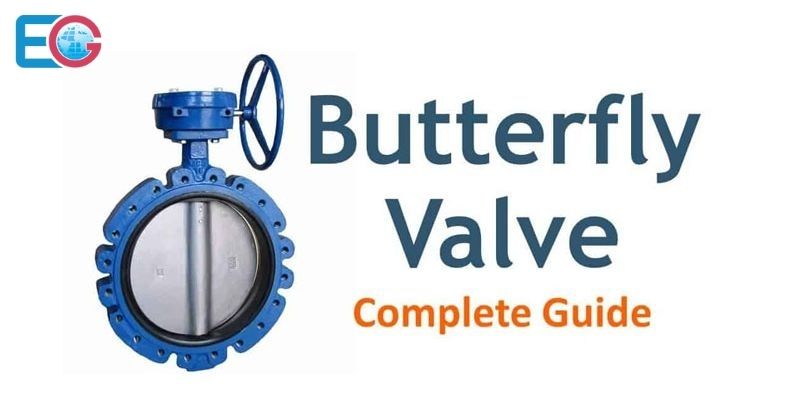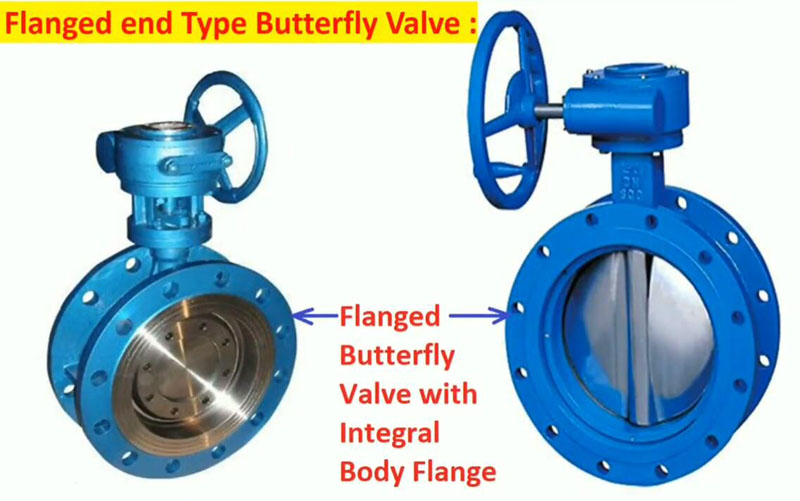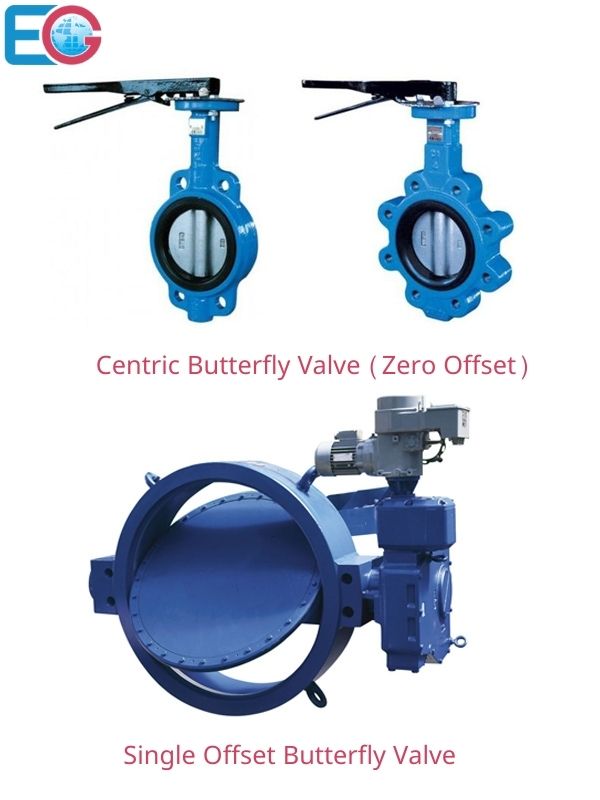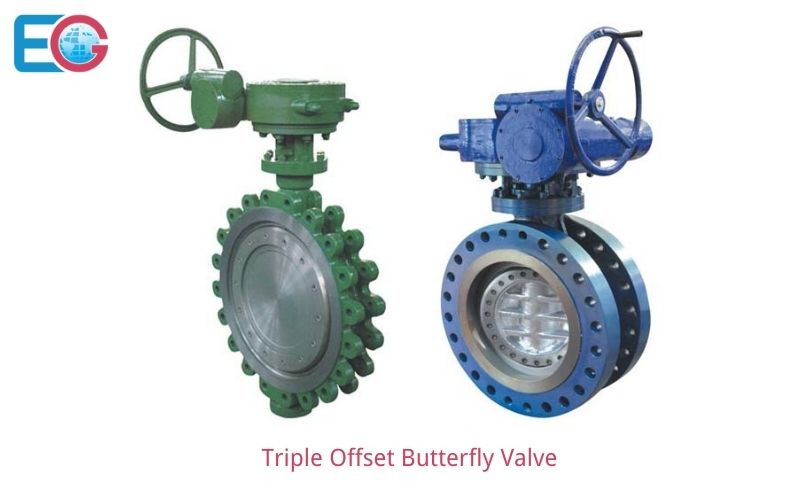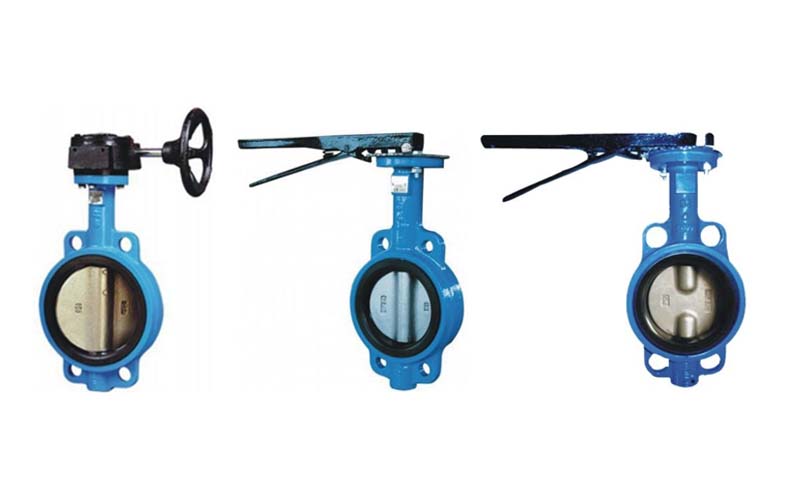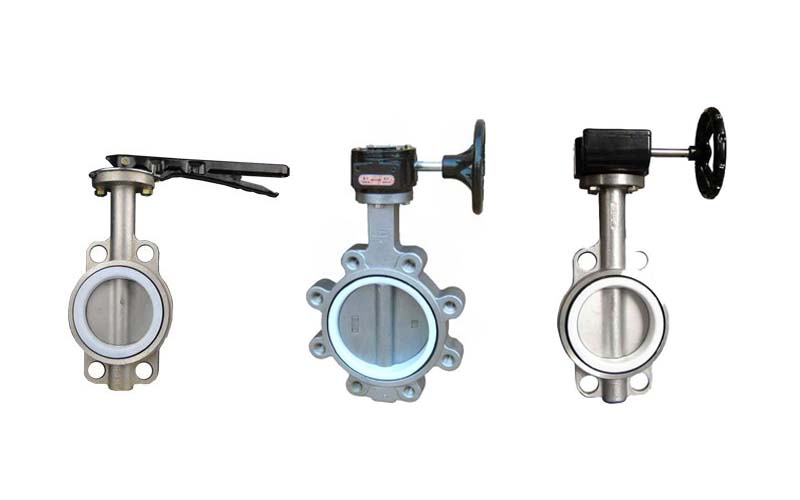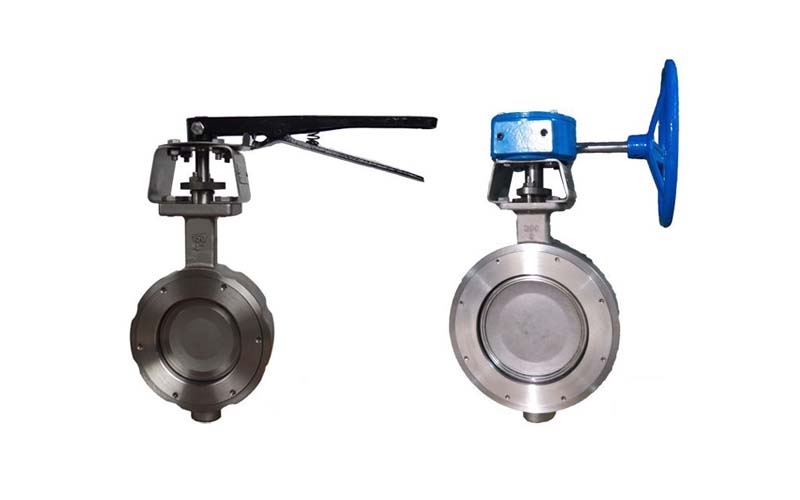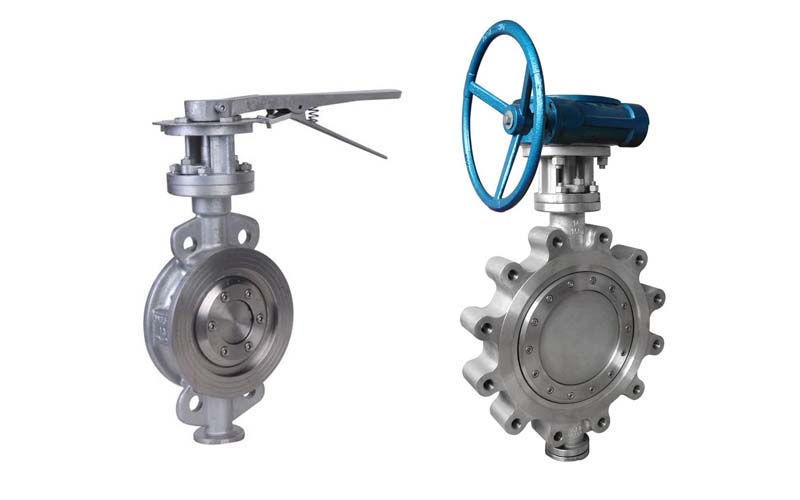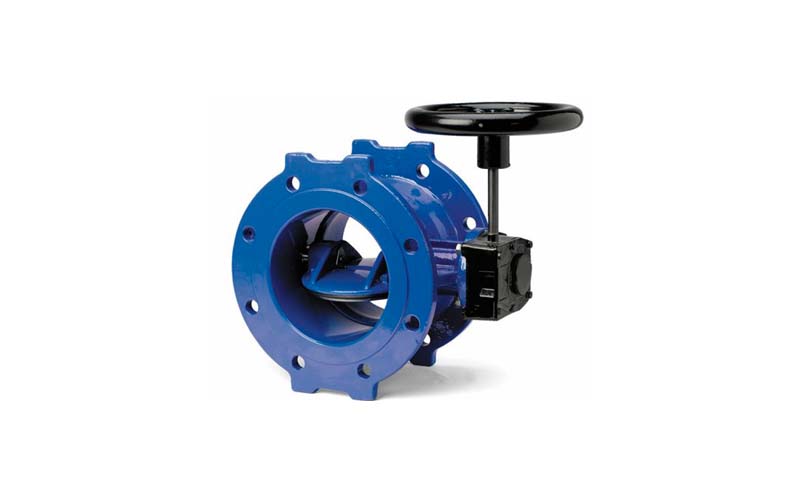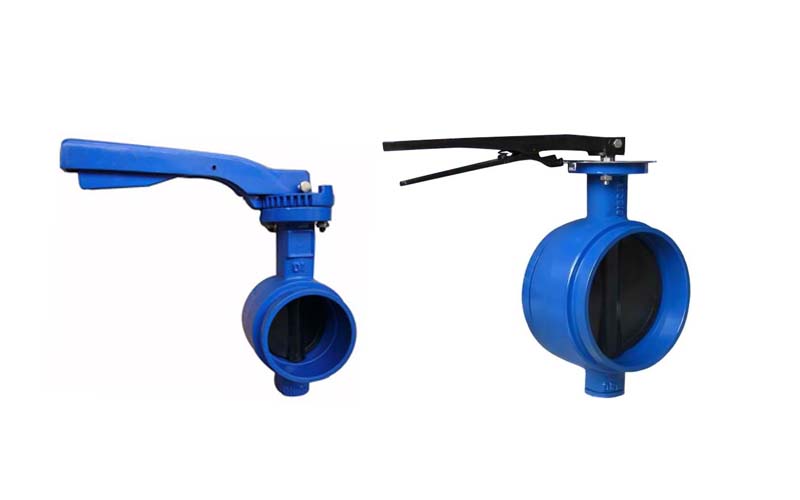Butterfly Valve China
EG Valves Supply Best Butterfly Valve China include Resilient Seated Butterfly Valve, High Performance Butterfly Valve, Triple Offset Butterfly Valve, etc.
The Complete Guide of Butterfly Valve China
Basics: What is a Butterfly Valve?
A prominent type of valve, the butterfly valve is a quarter-turn valve that can regulate, start, or stop the flow of media through the pipes attached to it. Because these are quarter-turn valves, butterfly valves take little time to open. From an engineer’s perspective, this is a huge bonus.
The ‘butterfly’ part of this valve is the metal disc in it that’s typically placed on a stem. Turning the valve completely shuts off the passage and opens further via the quarter-turn action.
One of the regulated rotary valves where the disc is mounted atop the rotating stem, the butterfly valve china can start, stop or modify the flow of elements through it with effortless ease, unlike its counterparts. Technically, it regulates the flow of pressure or liquids by throttling, balancing, or accelerating the same using a disc-shaped seating element. The seat in this valve flutters to regular the flow about a finite stem assembly.
Referred to as a type of quarter-turn valve, there are many applications and uses of the butterfly valves across different industries. It debuted first in the 18th century and has since then become engineers’ favorite owing to its special features.
When you rotate the handle of the valve by 90-degrees, the butterfly valve can be completely opened or closed. You’ll notice something called a ‘gearbox’ in most large butterfly valves. They are thus named because of their connection to the stem of the valve using gears. While it simplifies the valve function, watch out because such a gearbox will cost you in speed.
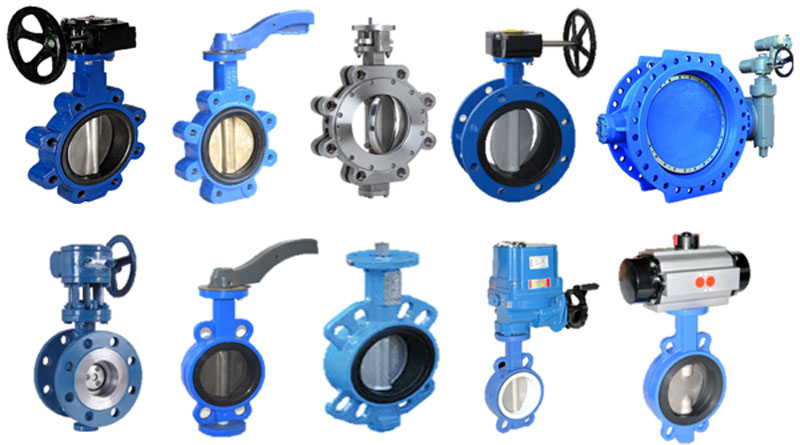
The butterfly valve china is one of the valves in the family of quarter-turn valves that starts, stops, or regulates the flow of media. It’s called a ‘butterfly’ valve owing to a disc that connects to a rod and moves like a fluttering butterfly.
Upon rotating this rod at an angle of 90-degrees, the butterfly valve opens or closes. It’s quite famous in the industrial world for being quick, cheap, and light in weight. Butterfly valves use levers/handles, gearboxes, and pneumatic or electric actuators (automatic) to operate.
When it comes to small-sized butterfly valves, manual operations are the norm while large butterfly valves use electric/motorized tools. In high-flow butterfly valves use small units that can help in bringing down your needs of cost, space, and weight magnanimously.
Butterfly valves consist of two parts that get wet. Thanks to innumerable valve lining, this type of valve can separate the body of the valve from the media that flows through it instead of costly coating and materials.
What are the Main Parts of a Butterfly Valve?
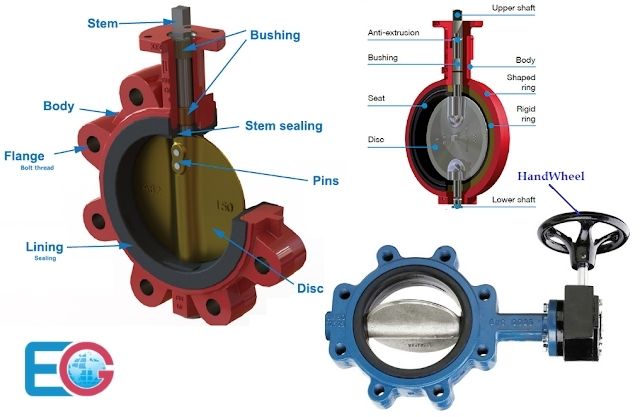
Now that you know what exactly a butterfly valve china is, it’s time to understand the various components so that you can begin to grasp how it works with precision and clarity.
- Body
Located between the pipe flanges, the body of the butterfly valve holds all the other parts of the butterfly valve in place. It can fit two pipe flanges and is the most common design used in lug and wafer types of butterfly valves.
- Stem/ Shaft
Enveloped by the disk and the seat, stem, or shaft of the butterfly valve remains protected in the resilient type of valves and immersed in liquid for high-performance types. It typically encompasses a single-piece or double-piece design of the shaft. A good design of the stem prevents the galling potential when used with other corrosion-resistant materials.
- Seat
Seen as a lining to the internal body of the butterfly valve, the seat is a type of rubber (EPDM, NBR, FKM, etc.) or metallic seal for preventing leakages. The design of the butterfly valve seat may differ from different manufacturers. It may even be locked, pressed, or bonded into the body of the valve.
Another kind of seat for this type of valve is made of flexible-type of PTFE material. Because it’s a seat made from a single piece of material sans any O-rings or metallic spring, the temperature isn’t limited thus reducing corrosive conditions to PTFE.
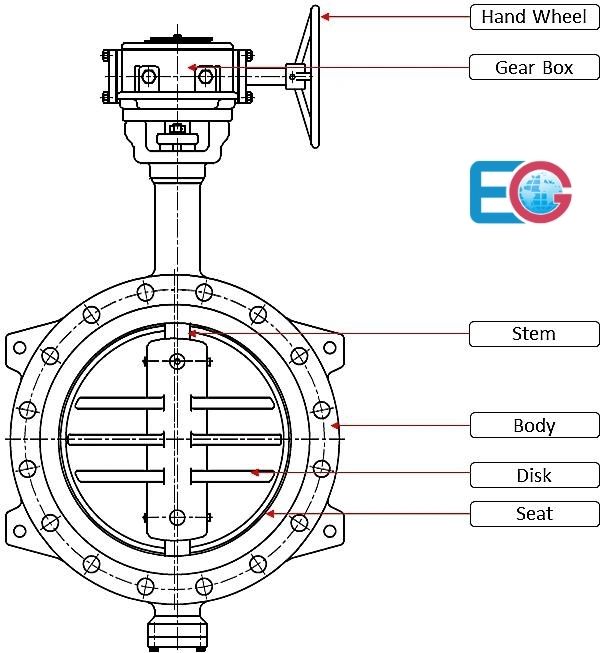
When the line pressure is applied, the complete cross-section of the butterfly valve seat gets pressurized. Hence, the disc faces many natural forms of deflections in undue pressure. For shutoff requirements, the butterfly valve seat makes use of the interference fit you see between the seat and the disc edge.
- Disc
With the body of the valve is a gate that prevents the flow of liquid or pressure through the valve and the same is made using materials required for specific applications.
Also called the disk, this is necessary to contain the flow of media for a butterfly valve. It can improve the flow of media as well as seal and enhance the torque during operation.
Keep in mind that there may be many different alternatives to the orientation and disc design of the valve.
In addition to the above, there are a few more components to a butterfly valve depending on the type you choose. These include the gearbox, ports, valve balls, spring, and trim. Do you want to know more about butterfly valve parts? Talk to our in-house experts today via the Contact Us page.
How does a Butterfly Valve Work?
If you know how a ball valve works, the working of a butterfly valve is even easier to grasp.
We already know that butterfly valves are famous for being the quickest and easiest valve to open. Moreover, this type can easily control and regulate media through the valve as well as isolate it based on needs.
When it comes to the disc of the butterfly valve, manufacturers like EG Valves ensure to use high-grade metal capable of resisting the conditions of the flow. The valve seat is typically made from high-quality rubbers or other viable metals. Check with the manufacturer if you need to know more about this.
Butterfly valves might sound sophisticated but it’s a simple and easy design that promises benefits for those looking to fit the valve into compact space or have a tighter budget. It’s ideal also for industries that use high volume and low-pressure liquid or gas media as well as those with suspended small particles.
Let us revisit the parts of butterfly valves for a second to fully understand how it works.
The body of the butterfly valve is an inevitable part that protects and shields its internal parts well. The butterfly valve body can be made of cast iron, ductile iron, carbon steel, stainless steel, alloy steel, and so on.
Next is the seat that’s crucial for sealing the valve with the disc. After the seat, comes the disc.
When properly fitted, the disc falls into space with the seat in the closed position of a butterfly valve. It’s a wafer-like mechanism that’s thin and situated in the center of the valve.
When paired with the seat, the disc seals the flow within the butterfly valve during isolation. The disc can also open or close partially to regulate the flow of media.
We will now look at the stem of the butterfly valve that links the disc with the actuator or lever that operates it. The valve opens with the force applied to the actuator that passes onto the stem. The disc is connected to the stem at the back or via the stem directly. It’s generally found fixed to the handle placed over the body of the butterfly valve or its sides.
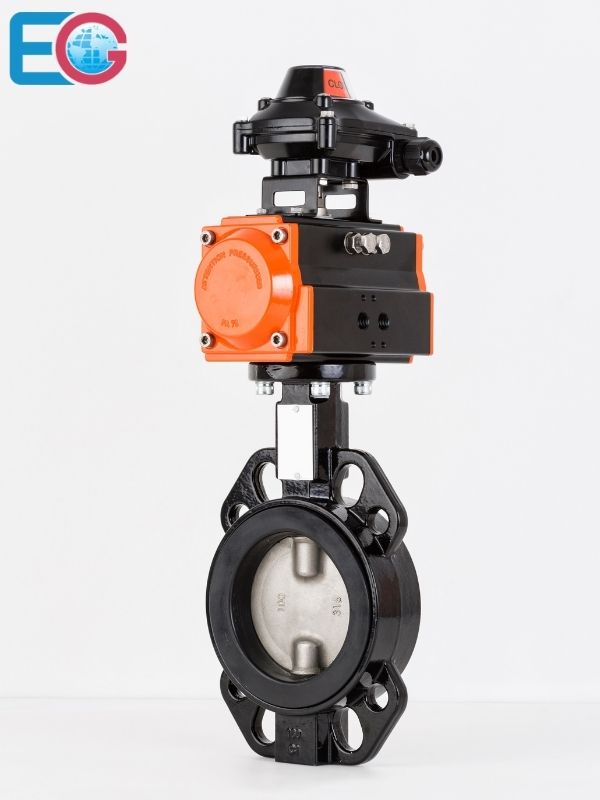
You can operate a butterfly valve manually, pneumatically, or electronically according to the specific working conditions.
If you decide to operate it electronically, the gearbox placed on the valve body will turn the stem to further move the disc based on remote source instructions. In the case of pneumatic operation, the piston on the body of the valve is used to create the required air pressure to open the butterfly valve. Practically, it’s the fastest actuation if you ask us manufacturers.
In order to open a butterfly valve, the handle is turned only a quarter. Within the body of the valve, this enables the disc to change from a perpendicular angle of the flow to a parallel mode. The disc also moves towards the center of the valve instead of being adjacent to the seat.
Keep note that at a quarter turn angle, the valve lets the flow of media pass at full throttle. In such a case, the pressure will drop a tad bit when you open the valve.
For closing the valve, another quarter turn action is required on the exact opposite side. When you do so, the parallel side of the disc moves into a perpendicular angle while fitting into the seat and sealing the apparatus. This is how a butterfly valve achieves full closure.
If you’re wondering about throttling, it occurs when the valve disc shifts from a closed position to a varied degree of angle that allows the flow of media to move minimally. The degree of angle here made by the disc with the center of the valve will help you determine how to regulate the flow of media through.
For installation, butterfly valves are typically placed in the open mode. This is because a closed-mode installation of the butterfly valve will wedge the soft seat on the disc, thus hampering any attempt to open the valve.
What Are The Different Types of Butterfly Valves?
Once you know the anatomy of butterfly valves closely, it’s time to look at the various types used for different end-purposes. So next we’ll analyze all the varied types of butterfly valves based on their core setup, material, and design.
By Different Body Construction.
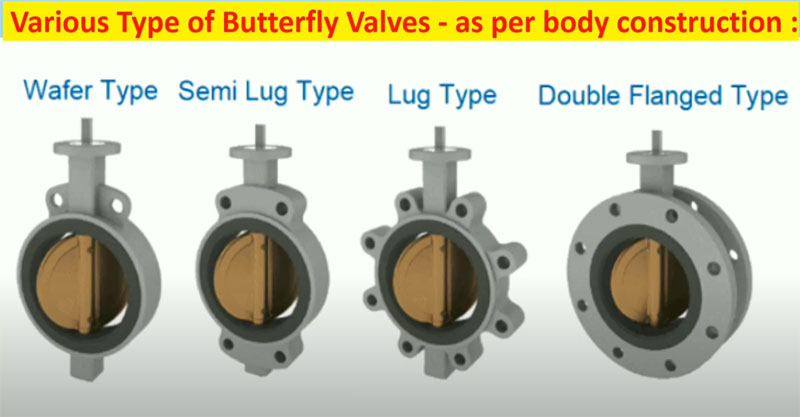
1. Wafer Type Butterfly Valve, which is also called Wafer Style Butterfly Valve.
Wafer type butterfly valve is one of the most common valve types in industrial pipelines. Wafer type butterfly valve itself has a relatively small structure. Wafer type butterfly valve is connected to two pipes by two or four sets of bolts/nuts. It is especially suitable for places with narrow space or a short distance between pipelines. When it is in a fully open position, the disc is the only resistance when the medium flows through the valve body. Wafer type butterfly valve can only be installed in the middle of the pipeline.
2. Lug Type Butterfly Valve, also called Lug Style Butterfly Valve.
Lug type butterfly valve has a complete set of lugs/flange shape on the valve body. It is connected to two pipes by full sets of bolts/nuts. For the same size, the lug type butterfly valve is heavier than wafer type butterfly valve. Meanwhile, Lug type butterfly valve can not only be installed in the middle of the pipeline, but also can be installed at the end of the pipeline due to it has a full circle of flanges. Some clients like lug type butterfly valve’s lugs are through-holes without inside threads, and some other clients prefer lug holes are UNC threaded.
3. Semi Lug Type Butterfly Valve.
This is quite like the wafer type butterfly valve apart from the thread bolt hole that you can find in the upper and lower sides used for easy maintenance of the pipe adjacent to it. The difference between Semi lug type and wafer type is Semi Lug butterfly valve’s lugs are thicker than Wafer type butterfly valve’s thin lugs.
4. Double Flanged Butterfly Valve.
The face-to-face dimension of the double flange butterfly valve must be longer than that of the wafer type or lug type butterfly valves. Both ends of the double flanged butterfly valve must have a circular outer circle with inner holes drilled according to the flange standards.
5. U Section Butterfly Valve, also called U type Butterfly Valve.
Sometimes when installing a butterfly valve, the face-to-face length for installation is relatively short. At this time, a double-flange butterfly valve with a short face-to-face length is required. Nowadays, most engineers call it a U Section butterfly valve or a U type Butterfly Valve.
By Different Mechanism.
1. Zero Offset Butterfly Valve. (Centric Butterfly Valve or Concentric Butterfly Valve.)
This Zero Offset Butterfly Valve has many names. It can be called Centric Butterfly Valve or Concentric Butterfly Valve, Resilient Seated Butterfly Valve, Rubber Seated Butterfly Valve, or Soft Seated Butterfly Valve. This kind of butterfly valve is mainly used for low temperature and low working pressure. This is a type of butterfly valve where the disc is on the centerline of the valve shaft for conditions of low pressure and ambient temperature. It’s also called Centric or Concentric butterfly valve due to the same reason.
When you open a zero offset butterfly valve, the disc in the middle partitions the flow of media into two perfect halves that are also parallel to the media. With a soft seat, flawless sealing is acquired when the disc ends up deforming the seat to seal it with friction during full operations.
Nowadays most people call it a Resilient Seated butterfly valve, Rubber Seated butterfly valve, or Soft-Seated butterfly valve. This centric butterfly valve is actually the most common kind of butterfly valve used in the world.
2. Single Offset Butterfly Valve, also named Single Eccentric Butterfly Valve.
Kindly note that the Single Offset is also called a Single Eccentric butterfly valve in the valve industry. The valve engineers invented this Single Offset Butterfly Valve which can guarantee a smoother option than the Zero Offset butterfly valves, Single offset Butterfly Valve gets its name due to the disc center is offset from the centerline of the valve stem, this offset design makes the valve can be opened or closed easier when compared to centric butterfly valve (zero offset butterfly valve).
Such a valve also lasts longer than others because the single offset of the valve on the stem ensures reduced contact. This is because the disc doesn’t contact the seat tightly as three to four-degree space is left unoccupied in such a type of butterfly valve.
3. Double Offset Butterfly Valve, also called Double Eccentric Butterfly Valve.
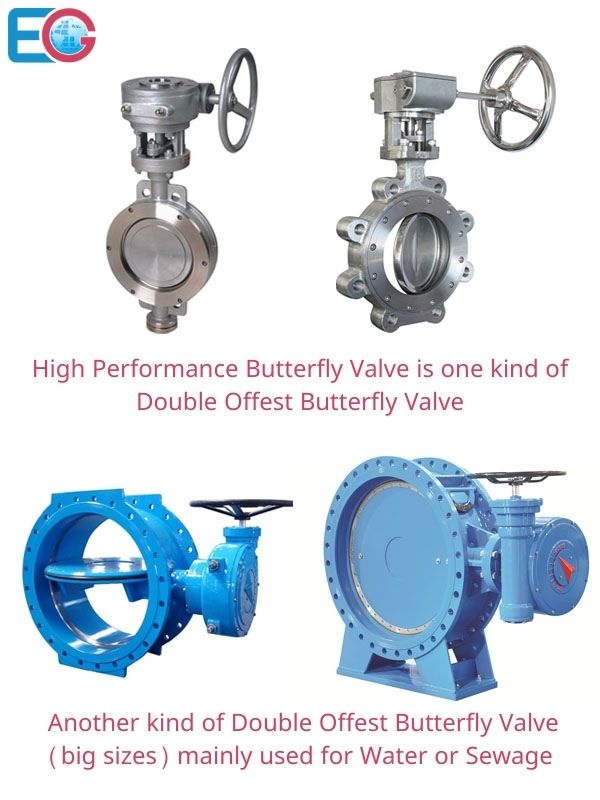
In Double Offset Butterfly Valve, the First offset is: Disc center is offset from the stem centerline and the Second offset is: Disc center is offset from valve body centerline. The double offset makes the opening and closing of the butterfly valve smooth with less friction which increases the valve service life and the operating torque can be lower.
Actually, there are two different kinds of double offset butterfly valves.
One famous kind of double offset butterfly valve is also called High Performance Butterfly Valve. It can withstand higher temperature and higher working pressure when compared to above mentioned Concentric / Centric butterfly valve which is rubber/resilient seated designed, that is why they are called High-Performance Butterfly Valve in valve industry. The High Performance butterfly valve supplied by EG Valves can range from DN40-DN1200. You can get PTFE and PTFE + metal seats. If you want to know more about its construction, welcome to contact EG Valves to get technical supports. High-performance double offset butterfly valves may be lug-type or wafer-type and may be made of materials like PTFE, glass, graphite, stainless steel, and Inconel metal too. They usually have a stem that’s blowout proof, universal mounting dimensions, rocker packing gland, anti-extrusion ring, jacking taps, seat retainer, thrust ring, and corrosion protection.
Please pay attention that there is also another kind of double offset butterfly valve, their sizes are all big and they are mainly used in large size pipelines, and the medium is mainly water or sewage. Most people call it Double Eccentric Butterfly Valve. Its inside construction is quite different from high performance butterfly valve. They have a big round rubber ring on their discs and for this reason it is actually a kind of rubber seated butterfly valve with a good sealing performance.
4. Triple Offset Butterfly Valve, also called Triple Eccentric Butterfly Valve. (API609 Design)
Triple Offset Butterfly Valve is also called Triple Eccentric Butterfly Valve. It is a metal-to-metal seated butterfly valve. It is also a great solution for high pressure and temperature conditions where a tight shut-off is required. As per our experience, the Triple Offset butterfly valve is the best design in the butterfly valve due to its perfect shut-off function.
It is called a triple offset butterfly valve because of three offsets as shown below:
● The disc center is offset from the stem centerline.
● The disc center is offset from the valve body centerline.
● The sealing cone is rotated away from the bore centerline.
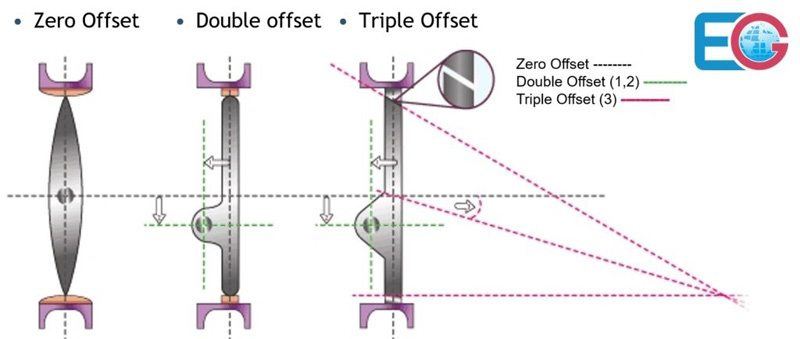
The triple offset geometry ensures seat and disc come into contact only at the final shut-off position. This design can not only reduce friction and wear, but also reduce the operating torque. Meanwhile, its service life can be longer than other kinds of butterfly valves.
In most industrial pipelines that use corrosive media such as steel, petroleum, iron, metallurgy, inflammable gases, etcetera, the triple offset butterfly valve helps in shutting off the system safely and sometimes to regulate the flow. Recently, triple offset valves have advanced miles to accommodate many kinds of connections such as wafer, lug, flanged, butt-welded, and jacketed types. It’s the ideal solution for alkali, acid, or other corrosive media at high and low temperatures owing to its compatibility with widespread materials. When it comes to butterfly valves with large diameters, triple offset valves are growing in trend and are being used instead of gate valves and ball valves owing to their zero leakage benefit.
Meanwhile, triple offset butterfly valves are also better than globe valves if regulation is your chief focus over the medium. For engineers looking for better control over liquid or gas media, triple offset valves can offer great isolation and a long lifespan sans any stagnation, friction, or depreciation of the seat. It self-compensates for any fluctuations in temperatures with a fire-safe design owing to its all-metal construction.
Triple offset butterfly valves are usually used for renewable energy, oil, gas, petrochemical, pipeline, storage, industrial gases, and chemical solvents on a daily basis. You can even get cryogenic and high-temperature customized triple offset butterfly valves for different purposes today.
By Special Function & Application.
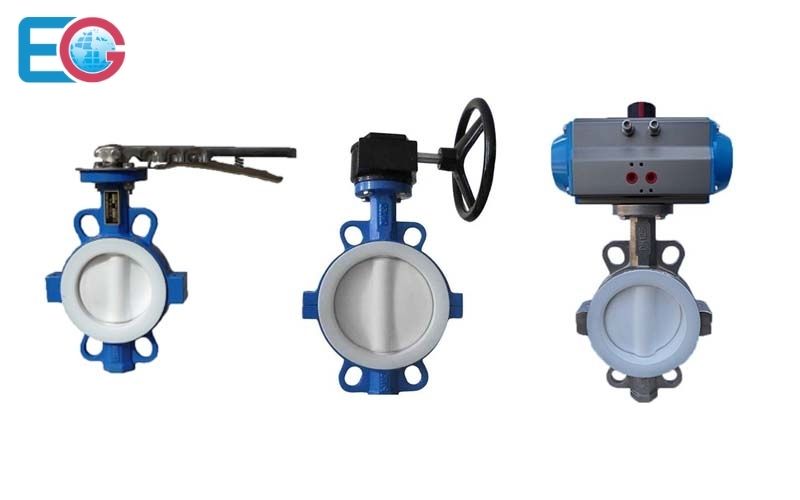
● Fluorine Lined Butterfly Valve
The best valve guaranteeing protection for the valve from chemical attacks, Fluorine Lined Butterfly Valve is essential to media involving sulfuric acid, aqua regia, hydrochloric acid, hydrofluoric acid, powerful alkali solvents, organic acids, strong oxidants, and even corrosive gases/liquids between temperatures of -50 to 150 degree-Celsius.
● PTFE Lined Butterfly Valve or RPTFE Lined Butterfly Valve.
Chemically called “Poly-Tetra-Fluoro-Ethylene”, PTFE was actually the first-ever synthetic fluoropolymer made by man. It’s the best solution for creating a coating for is non-stick crucial in food and cooking-related manufacturing. Pots and pans are usually coated with it for its non-corrosive properties.
With a Teflon lining of PTFE coating the rubber seat, this type of butterfly valve guarantees tightness and flexibility to the sealing rubber seat.
If you’re looking for the best valves compatible with highly corrosive and chemical conditions, PTFE-lined butterfly valves are an exclusive and fitting solution. These are meticulously made to ensure the flow of media passes without any troubles from the chemical side of the media.
Another benefit of PTFE-lining is that it makes sure the valve is resistant to corrosion and leakage that may happen during its function. The best thing is you can get PTFE-lined butterfly valves in a wide range of models and styles with respect to their unique specialties.
If you dig deep, you’ll even find case studies and fact files on industries that switched to PTFE-lined butterfly valves and ended up saving production costs.
Butterfly valves that are lined with PTFE can also save a lot of energy while making sure the production output is maximum.
One mustn’t forget the safety side of PTFE-lined butterfly valves because it showcases some of the best design features to prevent clogging, leakage, and routine faults. This makes it durable for a longer time interval than you might’ve thought. It’s undeniable that you need to pay more money to get a good quality valve nowadays.
If you don’t want your hard-earned cash to go to waste, find a reliable manufacturer with trustworthy experience in making PTFE-lined butterfly valves specific to your needs.
Moreover, with experienced manufacturers, you get the benefit of creating unique products exactly matching your needs using the experience and machinery they have without added costs.
At EG Valves, you get all these on your order of PTFE-lined butterfly valves at a fair fee. Send us an inquiry right now to learn more about the pros and cons of these valves so that you can get them at a reasonable cost.
We usually get clients from the industrial domains due to the many benefits of butterfly valves. You can run complicated processes easily and with additional stability. It can help you create an automated system with superb performance sans any manual interference.
Choosing a trustworthy and efficient manufacturer, preferably from the ‘world’s factory’ like China would help you enjoy the complete set of benefits of PTFE-lined butterfly valves. Keep note of the references and past works of the brands before you set out to work with them.
Polytetrafluoroethylene is actually a compound high-molecular-weight made of fluorine and carbon or a fluorocarbon solid. It’s a hydrophobic compound and thus protects the valve from water-related damages. Being hydrophobic, PTFE has sizable electronegativity making it ineffective by liquids.
PTFE-lined butterfly valves are useful in machinery that require low friction or low wear and tear. This synthetic polymer has a surprisingly low coefficient of friction when it contacts solid surfaces. PTFE is also called Teflon by some engineers. Teflon gets its name from DuPont, the famous American company which firstly invented it.
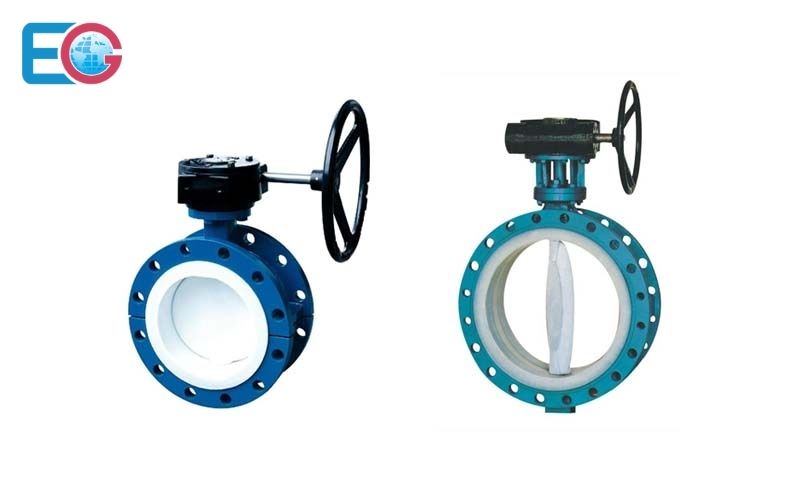
● FEP Lined Butterfly Valve
Chemically known as the ‘Fluorinated Ethylene Propylene’ with entirely different properties than PTFE. With added non-stick characteristics, FEP is great in the application that looks for resistance to oils and water. While it’s softer in nature than PTFE, it’s resistant to UV and sunlight.
However, you have to watch out for high temperatures as FEP can melt in such situations.
● PFA Lined Butterfly Valve
The chemical we’re talking about is Perfluoroalkoxy or PFA that contains alkoxy alternatives so that its polymer can undergo melt-processing. It’s quite different from PTFE when you look at it from the molecular level as it is composed of shorter chain lengths besides the fluoropolymers.
Butterfly valves that are lined with PFA also offer immense durability that makes it a great option in unfavorable weather conditions. It may also be recommended when the need is for material with high-chemical-resistance, low stiffness, and high purity. With a lower melting point than PTFE, PFE-lining ensures insulation to the butterfly valve while being UV-resistant.
Perfluoroalkoxy is a fluoropolymer with properties quite similar to polytetrafluoroethylene (PTFE) , the popular derivative of Teflon. PFA was known as Teflon PFA and was also created by DuPont Company. It’s distinct from PTFE resins because PFA is processable by melting. It’s usually done using injection molding with screw extrusion.
PFA typically features laboratory equipment where plastic is allowed because of the flexibility and transparent characteristics with high resistance to chemical damages. You might’ve also seen it as tubing for handling corrosive and critical processes. It may be evident in chemical equipment that mandates sheet lining too. FRPS or Fiber Reinforced Plastics find it easy to work with PFA as substitutes instead of costly metals or alloys.
When it comes to a quick comparison of PFA to PTFE, the former is a better alternative owing to its flexibility in particular, especially in tubing-related processes. However, the capacity of PFA of enduring flexing activities (called flex life) is lower than PTFE. It’s easily damaged by water and weathering while being better than PTFE in salt spray conditions.
The best thing about PFA when you put it against PTFE is its electrical merits. PFA is also noteworthy for its dielectric constant and a nearly-identical factor of dissipation. In fact, PFA possesses dielectric strength 3x or 4x of PTFE.
Teflon itself is considered one of the most crucial inventions of the 20th century with a wide variety of applications whether you’re looking for technicality or practicality.
Commonly used Body, Disc and Stem Materials of Butterfly Valves?
● Body
- Cast Iron Butterfly Valve, body GG25 or ASTM A126 Cl. B.
- Ductile Iron Butterfly Valve, body GGG40, GGG50, or A536 Gr. 65-45-12.
- Carbon Steel Butterfly Valve, body ASTM A216 WCB.
- Stainless Steel Butterfly Valve, body ASTM A351 CF8, CF8M, CF3, CF3M, etc.
- Aluminum alloy is also often used to make butterfly valve bodies.
- Titanium Alloy is another metal used to construct the body of butterfly valves.
● Disc
- Nickel Plated or Nylon Plated Ductile Iron is often used as butterfly valve discs.
- Carbon Steel with ASTM A216 WCB is used for making butterfly valve discs.
- Aluminum-Bronze alloy is used for butterfly valve discs with ASTM B148 and C95400.
- Stainless Steel 304, 316, 316L, 904L is commonly used butterfly valve discs.
- Duplex Stainless Steel F51, F53, F60, etc. can be also used for making discs.
● Stem
- Stem can be made of 1Cr13 (SS410), 2Cr13 (SS420), SS304, SS316, etc.
- 17-4PH is a strong stem material, commonly used for butterfly valves.
- Duplex Stainless Steel F51 and F53 are also used for making stems.
- Monel K400 / K500 or Aluminum bronze alloy C95800 can also be used.
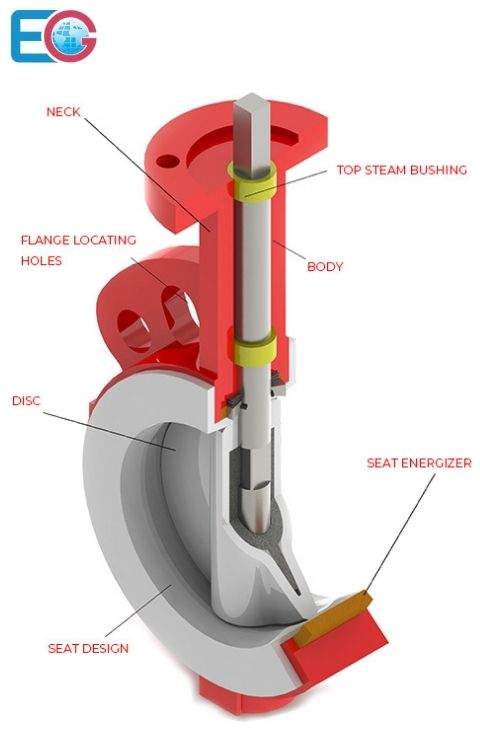
Commonly used Seat Materials of Butterfly Valves?
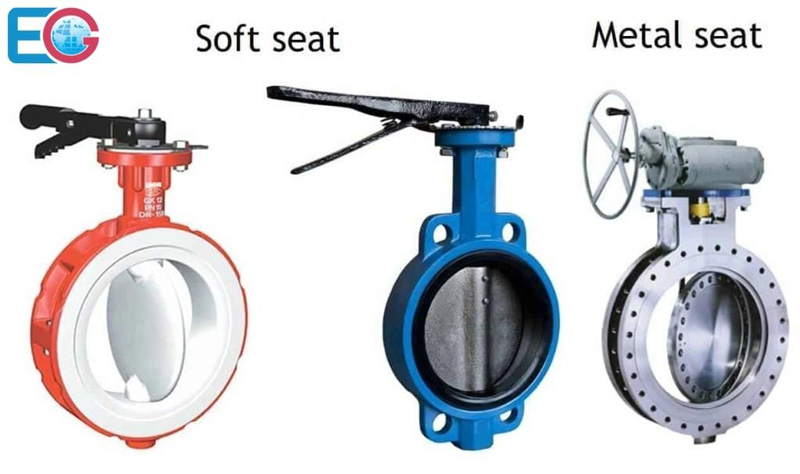
● Buna-N Seat
Also called the Nitrile Rubber, Buna-M Seats are used in specific temperature conditions such as those ranging from -20 degrees Celsius to 80 degrees celsius. It can also take up to 10 bars of pressure for liquids that aren’t aggressive or critical such as air, water, nitrogen, vegetable oil, petroleum while it can’t take oxygen.
● EPDM Seat
This is the second type of butterfly valve seat used for those ranging from -40 degree-Celsius to 130 degree-Celsius and a maximum of 10 bars of pressure. You can use it hassle-free with steam, hot water, normal water but you should keep off this valve for oxygen, grease, and oil.
● FKM Seat
Boasting great heat resistance up to 200 degree-Celsius, FKM also guarantees resistance to rust and corrosion. It’s resistant to ozone while there isn’t any cold resistance. FKM butterfly valves also come with excellent oil and chemical compatibility. All that being said, note that FKM butterfly valves aren’t cheap.
It’s called a Viton seat and great for -20 degree-Celsius and up to 16 bars of pressure. Viton favors steam, water, hot water, air, nitrogen, acids, and even aromatic liquids.
● PTFE / RPTFE Seat
PTFE Seat as we learned is also named Teflon Seat is often apart from the RPTFE Seat. R means Reinforced, which uses glass fiber to reinforce PTFE. Since a certain amount of glass fiber is added in the process of making RPTFE, the infrared absorption of this part will be different from that of pure PTFE.
It’s great for butterfly valves that need to resist the coldest and hottest temperatures such as those ranging from -200 to +210 degree-Celsius. The best thing is the 200 bar pressure it can take. It’s the best solution for cryogenic liquids and corrosive media too.
● Stainless Steel Metal Seat
Seats in butterfly valves made of stainless steel can also take low temperatures of -200 degree-Celsius as well as the hottest of +500 degree-Celsius with 200 bars of pressure. It’s great for corrosive and cryogenic liquids too.
● Inconel Metal Seat
Made from nickel, chromium, titanium, and molybdenum, Inconel metal can take up to +700 degree-Celsius and -29 degree-Celsius at the lowest. It’s great for critical liquids that need pressure up to 200 bars.
What are the Advantages of Butterfly Valves?
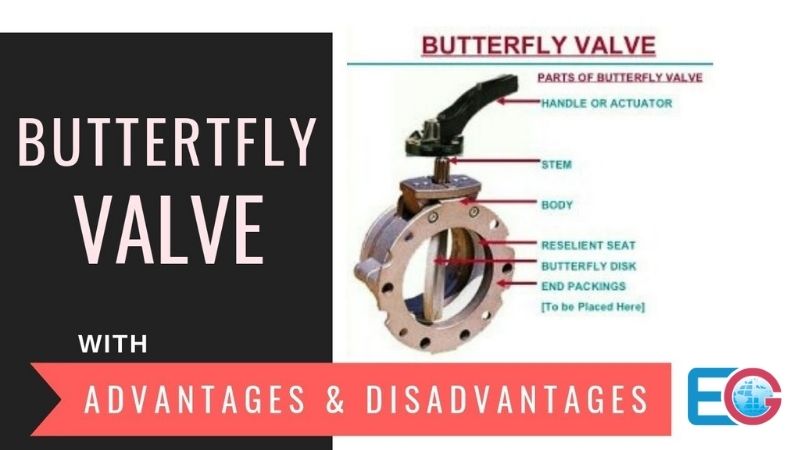
You now know all about how the butterfly valve works. It’s time to assess the advantages and disadvantages of this type of valve before finalizing it for huge operations and applications.
Here are its advantages to know most importantly about before ordering or using:
- Quick installation: Butterfly valve takes less time than other valves to install as often it takes just a couple of bolts and no nuts to set it up.
- Throttle the flow of media: Unlike most of its competitors, butterfly valves can easily throttle the flow.
- Compact: Because such a valve doesn’t take a lot of space to fit in, it’s easy to create your own configurations without hassles.
- Low loss of pressure: This valve is known for its high-pressure recovery, thus resulting in efficient management in low-pressure and low-temperature systems.
- Light in weight: This is a reason why using butterfly valves is easy for all types of professionals, especially owing to its quarter-turn flow. When compared to ball valves, the discs of butterfly valves are lighter in weight.
- Cheaper than others: Due to the fact that a lesser amount of materials are used in the construction of butterfly valves when compared to others, it costs less to construct
- Less maintenance: When it comes to most valves, the hassles of maintenance are typically high. But, you don’t have to worry about intensive maintenance procedures for butterfly valves due to their high durability. Moreover, you can install or uninstall the valve without disturbing the pipe system.
- Customizable: Butterfly valves are fully customizable with full stainless steel or lightweight aluminum bodies too.
- Ideal for food industries: Due to the backflow prevention mechanism available in these valves, it’s easy to maintain sanitary conditions especially in areas where it’s inevitable.
What are the Disadvantages of Butterfly Valves?
These are the demerits for this type of valve just as there are merits and a good engineer always considers both before deciding on the right butterfly valve.
- Flow interruption problems: One of the biggest demerits of this system is that the disc in the butterfly valve can break the flow of the system when it’s open.
- Common Issues: Rarely choked flow and cavitation can occur in butterfly valves.
- Unsuitable for high differential pressures: While it ensures low loss of pressure, butterfly valves aren’t fit for high-pressure situations. There will always be a pressure switch due to the disc-type of design of the butterfly valve no matter what setting it’s in.
What are the Uses and Applications of Butterfly Valves?
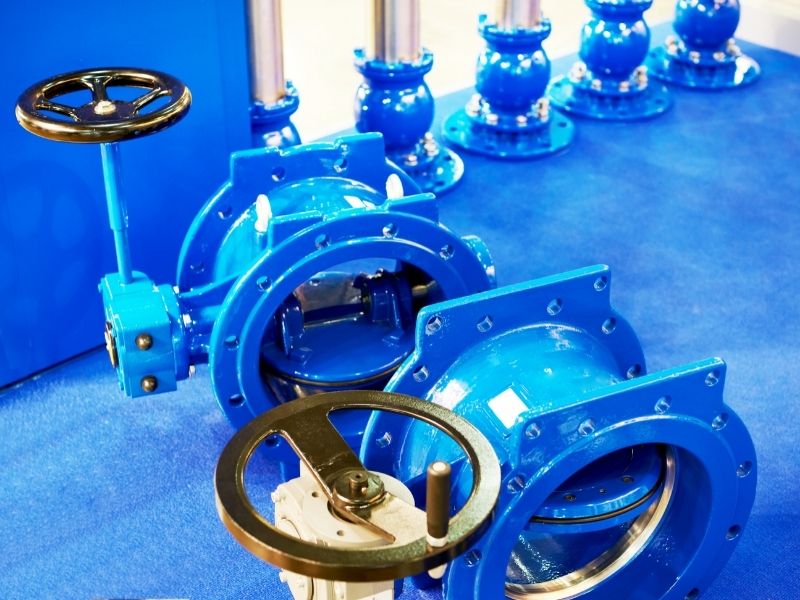
Just like gate valves and ball valves, butterfly valves show up in a range of industries all around us. It’s great for high and low temperatures besides boasting great durability and resistance to most things.
The following will list all the popular applications of butterfly valves so that you can derive similarities and benefits for your project.
- Heating, Ventilation, and Air Conditioning: Many HVAC systems use butterfly valves such as lug, wafer, and tapped valves made of ductile iron, stainless steel, and carbon steel.
- Food and Agriculture: Butterfly valves are often considered a sanitary necessity in food-related machinery and those made from stainless steel can even last for a century. They are easy to maintain and clean besides preventing contaminants. On the other side, aluminum wafer types of butterfly valves are commonly used for water and other needs in the agricultural industry.
- Medicines and Pharmacy: Pharmaceuticals use butterfly valves the most of any other industry. It’s perfect for dry bulk transfer and delicately controlled handling of products. You’ll mostly see PTFE-lined butterfly valves in the pharmaceutical industry.
- Waste Management: Treatment processes of chemical and biological wastes often include butterfly valves same as aeration systems. Soft seated butterfly valves are a common sight in treatment plants across the world.
- Petrochemical Plants: While ball valves are the norm in this industry, butterfly valves are also a good fit in oil and gas requirements where regulation and quick shut-off takes priority.
- Refrigeration Systems: Installed in the refrigerant cycles of commercial refrigerators, butterfly valves in this manner are flanged and made of stainless steel with temperature resistance ranging from -15 degree-Celsius to +150 degree-Celsius.
- Fire Protection: Butterfly valves are commonly used for industrial gases and even corrosive liquids that can cause fires. But owing to its lightweight nature butterfly valves house the stem, disc, and seat of the valve with the EPDM rubber lining for chemical and weather protection.
- Slurry Management: Cheaper costs of butterfly valves make it a great alternative for managing slurry while preventing redirection of the flow and negligible interference with the abrasive media.
- Corrosive Processes: Metal seated butterfly valves are best for controlling the flow of corrosive media within pipelines. There are many corrosion-resistant alternatives today with respect to the media you’re targeting.
Apart from the above, the two chief uses of butterfly valves are the regulation of fluid flow with a sensing monitor, flow isolation for varying pressures, and backflow prevention across industries with extreme wash down systems.
How to Choose the Right Butterfly Valve for Your Projects?
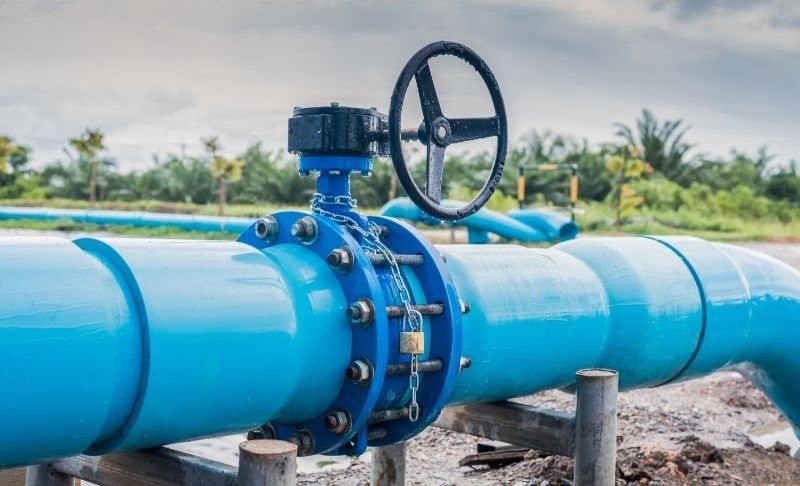
Butterfly valves can help you replace gate valves, ball valves, and more. Once you’re sure that you need butterfly valves for your needs, the next step is to find out where to buy them with ‘better-than-wholesale-quality’.
Before you commit to thousands of butterfly valves that may or may not work for you, it’s best to follow the best practices listed below. It will help you refine your search and find the best supplier for high-quality valves. Doing so will also save you hundreds and thousands in the long run.
Take a look at what to do below.
- Credibility and reviews: The first thing to check when looking for a viable manufacturer is the testimonials of their past customers. The same will help you rate their work and understand their capabilities as well as limitations
- Inspection and QC: The next step is to assess the quality of their products by inspecting the products delivered for dents, scratches, and damages. Also check if the disc is secure, the sealability of the valve, and the newness of the seat. You can also go through their quality control measures to check if it fits with your needs
- Approvals and tests: The most important step to ensure that you get high-quality butterfly valves is the ISO standard that ensures that the factory follows valve standards and procedures for manufacturing these valves.
- Cost: One of the foremost things that affect your choice of China butterfly valves is the budget. Check these suppliers so that you can avail savings on the order or negotiate based on your estimations.
- Minimum Order Quantity (MOQ): Always check if the MOQ is feasible before shortlisting or confirming the order as suppliers may often have a high minimum requirement.
- After-sales tasks: The best way to spot a good valve manufacturer is by the responsibility they take for the product post the purchase.
- Material: Also consider the core material of the stem, body, and disc of the valve, you must pick the best one because it’s compatible with the media you’ll be using.
- Carefree: You know that maintenance is minimal with butterfly valves but do you know why? That’s because butterfly valves are actually self-cleaning and more sustainable than their competitors.
- Extra characteristics: From fire safety to lead-free valves with high performance, there are several additional ways to find the best butterfly valve for your needs.
- Miscellaneous: Lookout for flow area of the piping system besides checking friction loss on the walls of the pipe and how the flow direction changes due to fittings. The flow factor is 3x better than globe valves for butterfly valves with 25% lesser in size than the former. Moreover, gate and globe valves can’t offer bubble-tight shut-off butterfly valves.
What are the Quality Control Measures of Butterfly Valves at EG Valves?
At EG Valves, QC inspections are periodic, strict, and meticulous to ensure high-quality products. From pressure tests to personal inspections, every butterfly valve undergoes several stages of inspection before reaching you.
Take a brief look at the QC tests at EG valves for butterfly valves to get a clearer idea.
Here’s a list of tests we do on butterfly valves:
- Raw Materials Inspection of all metals to alloys and materials used for constructing butterfly valves.
- Shell Test for butterfly valves for all ASME Classes.
- The backseat Test for testing leakage of the valve is quite like the shell test.
- Response spectrum analysis to ensure the structural safety of the valve.
- Chemical Analysis to ensure the valve can take toxic media and corrosive media without hassle.
- Block And Bleed Pressure Closure Tests
- High-Pressure Pneumatic Tests
- Test Fluid, Pressure, And Duration
- Retesting of the components and final product
- Visual Investigation Of Castings
To get a detailed outline of our quality control procedures for butterfly valves, send an inquiry to our customer service team today.
How are Butterfly Valves Packed before Shipment at EG Valves?
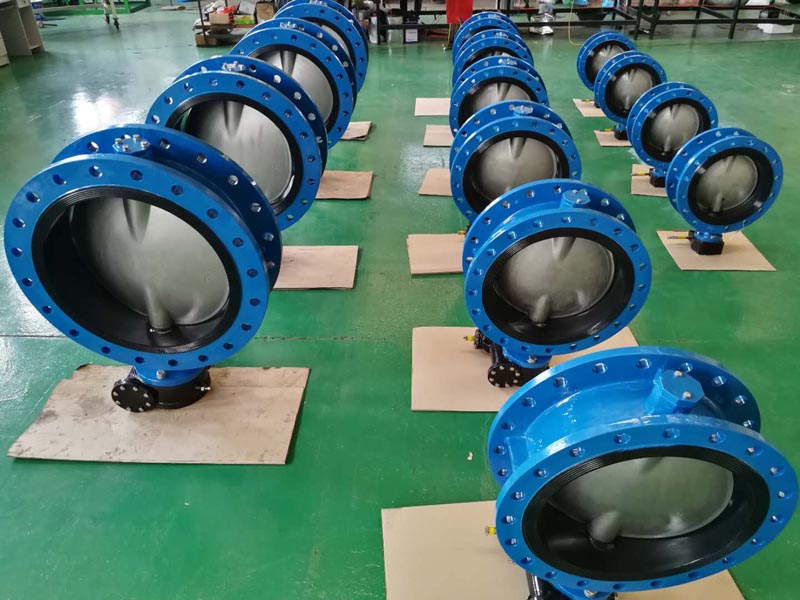
When it comes to shipping butterfly valves to your address, we take maximum care to minimize any shipping-related damages. This includes any bruises or blemishes that can occur during packaging too.
Throughout our time of working with different valve buyers from various areas of the world, we’ve come to realize different packaging that works for different shipping modes, duration, and more without compromising on the quality of the valves.
Our expert team thoroughly assesses the size of the valve, its dimensions, specifics, model, weight, and order amount with respect to your order prior to shipping. After the warehouse manager investigates whether the butterfly valve and its components are up to the mark, the valve is packed.
In case you’ve asked for exclusive shipping, our team would go the extra mile to ensure everything is followed to the dot.
Otherwise, valves are packed in exclusively designed polybags with an exterior packaging of plywood which is lined with tarred paper and another plywood. The same structure of plywood layers is also applied to valve packaging with layers of products.
Outside the plywood is an iron tape coating that prevents further damages or depreciations that the shipment can suffer during transit.
When it comes to premium packaging, plywood guarantees the best protection from hits and bumps besides keeping off humidity from moisture from your valves. Environmental conditions that can trigger damage in closed conditions up to three months are taken care of when valves are packed by the manufacturer.
Finally, we label the package according to your requirements.
Why Choose EG Valves for your Butterfly Valve Supplier?
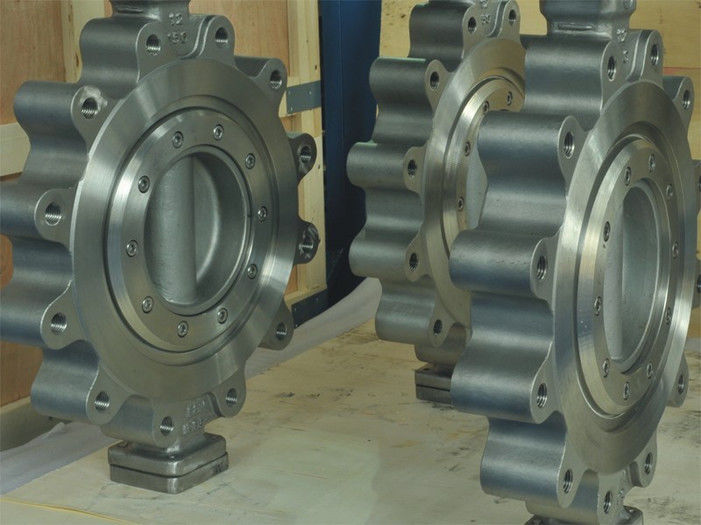
Being a pioneer in the industry since the turn of the millennium, EG Valves is a valve expert with established factories and an advanced R&D setup. When you decide to order with EG Valves, our sales experts get you the best valves at the best deal without leaving your hand every step of the way.
You can get different types of butterfly valves with us such as resilient-seated, high-performance, triple offset, and double offset. Apart from the formalities of getting state-of-the-art concern and care you’re guaranteed at EG Valves, here’s why you should go with us:
- Insurmountable experience of EG Valves accounts to our years catering for clients around the world.
- Lead Time Guarantee by EG Valves is short for bulk orders of butterfly valves.
- A wide variety of butterfly valves to choose from on our platform enables. This is great for brands because it enables you to grow, ideate, and scale your brand or production department with time or right away.
- Even more raw materials you can work with such as cast steel, alloy steels, ductile iron, cast iron, forged steel, and stainless steel.
- Our skilled customer service and sales team can answer your queries and help you select the best type of butterfly valve easily.
- Multi-faceted delivery and shipping is a forte of EG Valves as we provide delivery via air, sea, and land using services such as LCL, FCL, UPS, DHL, and FedEx.
- Best quality with thorough inspections and compliances with ANSI, ADPI, JIS, and DIN.
- We also accept medium and small orders so if you’re a small-sized business, don’t shy away from getting your order in the pipeline ASAP!
What are the main International Standards for Butterfly Valves?
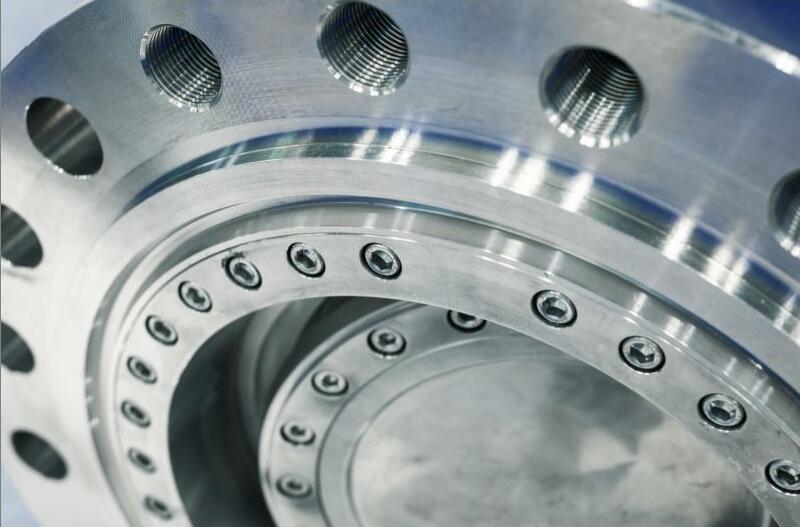
When it comes to butterfly valves, there are several tests and compliances we’ve discussed above. In this section, we will outline and find out all the specific international tests and inspections for different parts of butterfly valves.
- API 609: An American Standard for valves for flow modulation of butterfly valves with metal or soft seats. It’s basically category A and B with A involving concentric butterfly valves and B related to offset types.
- AWWA-C-504: Rubber Seated Butterfly Valve.
- API 598: This international standard involves tests and inspections of butterfly valves to ensure the pressure boundary of metallic valves. This helps to determine the structural surety and tightness of butterfly valves.
- ISO 5208: Checks for visual leakages in the butterfly valve and determines safe leakage acceptance rates.
- DIN 3230: This includes delivery conditions for valve delivery besides some testing.
- EN 12266: With this model, the pressure resistance of butterfly valves is
- ISO 5752: Used for triple-offset, resilient-seated, double-flanged valves to keep the dimensions universal.
- BS 5155: Seen with wafer and double-flanged type of butterfly valves with pressure ability of PN 40 of Class 300 and in sizes DN 2000.
- MSS-SP-68: Concerning high-pressure butterfly valves with offsets, MSS-SP-68 includes design specifications, performance inspections, marking criteria, and labeling of butterfly valves.
How to Choose the Best Butterfly Valve Manufacturer from China?
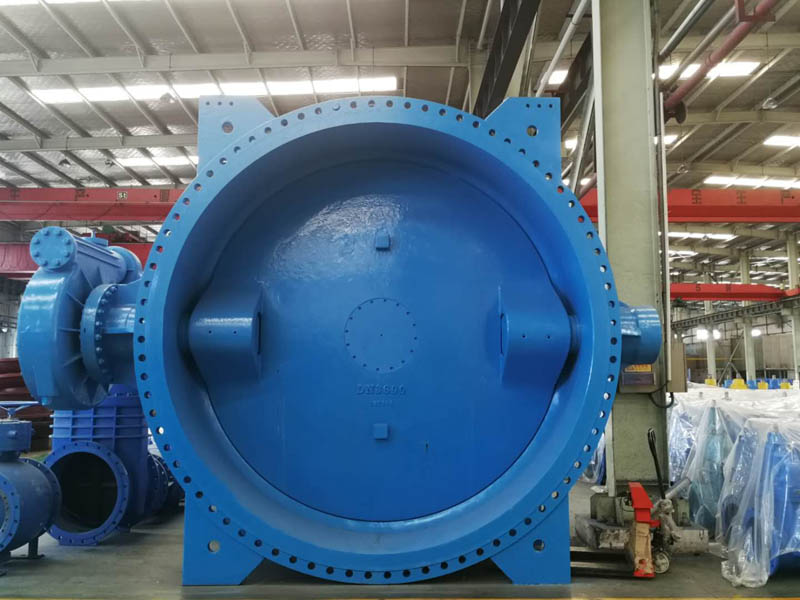
When you’re looking for the best place to order butterfly valves from China is definitely at the forefront of the butterfly valve supplier market. At EG Valves, we have years of experience and a dedicated R&D too.
Next, we’ll cite a few points to help in the right direction of butterfly valve manufacturer in China.
- Step One: This is where you get acquainted with the manufacturer. In effect, this is where you send a detailed inquiry citing your specifications of the butterfly valve. But it all starts with the question of whether the valve you’re interested in is available in stock firstly.
- Step Two: Next ask about the model and type including dimensions when you finally start talking with a sales representative.
- Step Three: When it comes to the designing of butterfly valves you should ask where their raw materials come from as well as about their origins. Request CAD and prints of the valve you’re planning to order so that you can assess whether it matches your needs.
- Step Four: The prototype of the butterfly valve you’re interested in can be requested from the manufacturer so that you can check it by hand to ensure everything is accurate.
- Step Five: After approving the prototype, the manufacturer can do their own testing to see if it passes international standards for the end purpose it’s destined for.
- Step Six: This is when you approve the final design based on test results and experts’ conclusions.
Conclusion
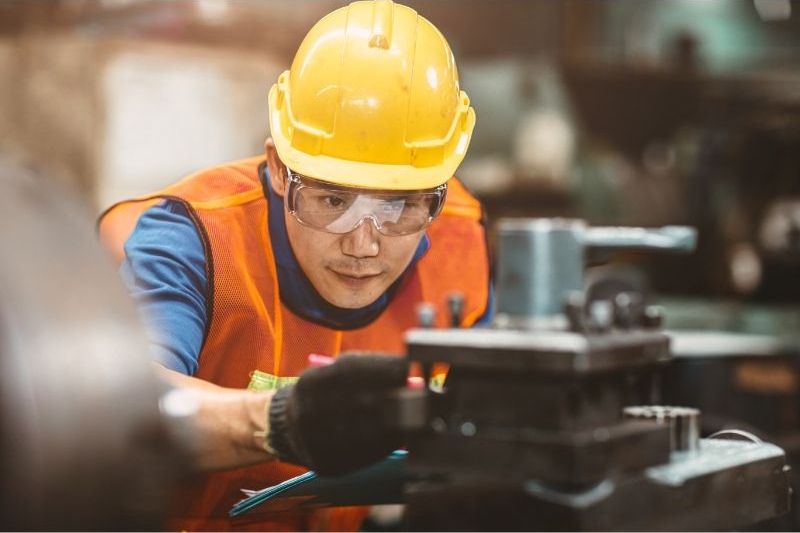
Finding a good butterfly valve supplier & manufacturer isn’t an easy task. The first thing to do is understand what exactly a butterfly valve is.
Just as the name says, it’s a fluttering valve shaped like a butterfly. The function of this valve is to modify, start, or stop the flow of liquid or pressure in a system. It’s widely seen in industries concerning health, food, chemicals, oil, gas, lubrication, and so on.
There are four parts to a butterfly valve such as body, stem or shaft, disc, and seat. You will find ten types of these valves such as lug-style, wafer-type, metal-to-metal, resilience seated, etc. Butterfly valves are lightweight, easy-to-install, and use, besides being cheaper to make and affordable too. However, it’s not ideal for high-differential pressures and also causes alarms when it starts to flow without breaks.
If you’re ready to choose a China butterfly manufacturer, it’s best to start by checking their reviews first. Then proceed to QC, cost, tests, MOQ, and after-sales offered by them. Once you’re sure of the product and samples, proceed to buy.
You already learned how the butterfly valve works above, so here’s a quick brief:
- An electric actuator is used for operating butterfly valves in both closed and open positions
- Pneumatic actuators use compressed air to open or close pipelines between systems
- The hydraulic function makes it easy for opening and closing the valves used in applications that require huge force.
- Manual operations include handwheel , gearbox, or worm gear operation
- With different types of butterfly valves based on its body, disc-alignment, function, seat, stem, and body like wafer-type, lug-type, zero-offset, double-eccentric, and PTFE-lined. Some butterfly valves may be right for corrosive liquids and others can work for water, seawater, or even gases.
The main pros of butterfly valves include quick installation, easy maintenance, low differential pressure, lightweight nature, throttling, cost-effective, and customizable. While it can face flow interruption at times, butterfly valves are great for a range of industries from HVAC to pharmaceuticals, food, agriculture, refrigeration, oil, gas, petrochemicals, slurry management, etcetera.
You learned how to pick the right butterfly valve and how to find the best China butterfly valve manufacturer for the same. Our two decades of experience have helped to manufacture unique valves for many leading brands around the globe.
If you’d like to learn the ropes from an experienced manufacturer, don’t hesitate to contact our experts for ASAP responses because we’re always online!

